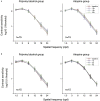The Effects of 0.01% Atropine on Adult Myopes' Contrast Sensitivity
- PMID: 33679306
- PMCID: PMC7933202
- DOI: 10.3389/fnins.2021.624472
The Effects of 0.01% Atropine on Adult Myopes' Contrast Sensitivity
Abstract
Purpose: Atropine at a low concentration is considered a safe and effective treatment to mitigate myopia progression. However, the potential unwanted side effects of administering atropine at a low dose on visual functions other than best corrected visual acuity has not been investigated. In this study, we investigate the short-term (12,16, and 20 h) and long-term (1, 2, and 4 weeks) effects of 0.01% atropine (i.e., 0.1 mg/ml) on contrast sensitivity (CS) in patients with myopia.
Methods: Thirty adults (23.33 ± 2.93 years old) with myopia between -1.00 and -6.00 diopters (D), astigmatism of -1.50 D or less, and anisometropia of 1.00 D or less, participated in this prospective, masked, placebo-controlled, randomized study. The participants were randomly assigned to receive 0.01% atropine or polyvinyl alcohol eye drops once nightly to both eyes for four weeks. CS was measured binocularly at baseline and 12, 16, 20 h, 1, 2, and 4 weeks after the first use of the eye drops.
Results: There was no statistically significant differences of CS found between atropine and placebo-controlled groups in both short-term and long-term. There was no statistically significant interaction effect found between the time and group.
Conclusion: We demonstrated no significant deleterious effect of 0.01% atropine on adult myopes' CS.
Keywords: atropine; contrast sensitivity; myopia; myopia control; visual perception.
Copyright © 2021 Cheng, Mei, Cao, Zhang, Zhou and Wang.
Conflict of interest statement
The authors declare that the research was conducted in the absence of any commercial or financial relationships that could be construed as a potential conflict of interest.
Figures




Similar articles
-
Low-Concentration Atropine for Myopia Progression (LAMP) Study: A Randomized, Double-Blinded, Placebo-Controlled Trial of 0.05%, 0.025%, and 0.01% Atropine Eye Drops in Myopia Control.Ophthalmology. 2019 Jan;126(1):113-124. doi: 10.1016/j.ophtha.2018.05.029. Epub 2018 Jul 6. Ophthalmology. 2019. PMID: 30514630 Clinical Trial.
-
Atropine for the treatment of childhood myopia: effect on myopia progression after cessation of atropine.Ophthalmology. 2009 Mar;116(3):572-9. doi: 10.1016/j.ophtha.2008.10.020. Epub 2009 Jan 22. Ophthalmology. 2009. PMID: 19167081 Clinical Trial.
-
Efficacy and safety of 0.01% atropine for prevention of childhood myopia in a 2-year randomized placebo-controlled study.Jpn J Ophthalmol. 2021 May;65(3):315-325. doi: 10.1007/s10384-021-00822-y. Epub 2021 Feb 14. Jpn J Ophthalmol. 2021. PMID: 33586090 Clinical Trial.
-
Interventions to slow progression of myopia in children.Cochrane Database Syst Rev. 2020 Jan 13;1(1):CD004916. doi: 10.1002/14651858.CD004916.pub4. Cochrane Database Syst Rev. 2020. PMID: 31930781 Free PMC article.
-
Low-Concentration Atropine Eye Drops for Myopia Progression.Asia Pac J Ophthalmol (Phila). 2019 Sep-Oct;8(5):360-365. doi: 10.1097/APO.0000000000000256. Asia Pac J Ophthalmol (Phila). 2019. PMID: 31478936 Free PMC article. Review.
Cited by
-
Low-concentration atropine (0.01%) on quantitative contrast sensitivity function in Chinese children with myopia.Int J Ophthalmol. 2025 Jan 18;18(1):117-124. doi: 10.18240/ijo.2025.01.14. eCollection 2025. Int J Ophthalmol. 2025. PMID: 39829610 Free PMC article.
-
Low-Dose 0.01% Atropine Eye Drops for Symptomatic Vitreous Floaters: A Noninvasive, Safe, and Effective Therapeutic Option.J Vitreoretin Dis. 2025 Aug 20:24741264251364819. doi: 10.1177/24741264251364819. Online ahead of print. J Vitreoretin Dis. 2025. PMID: 40852331 Free PMC article.
-
Short-term effects of ophthalmic topical 0.01% atropine on the ocular surface, pupil size, and subsequent subjective quality of vision in young myopic Chinese adults.Front Med (Lausanne). 2024 Sep 5;11:1436551. doi: 10.3389/fmed.2024.1436551. eCollection 2024. Front Med (Lausanne). 2024. PMID: 39301485 Free PMC article.
-
Safety of DIMS Spectacle Lenses and Atropine as Combination Therapy for Myopia Progression.Klin Monbl Augenheilkd. 2022 Oct;239(10):1197-1205. doi: 10.1055/a-1930-7116. Epub 2022 Aug 25. Klin Monbl Augenheilkd. 2022. PMID: 36008055 Free PMC article.
-
Optical Strategy Utilizing Contrast Modulation to Slow Myopia.Ophthalmol Sci. 2024 Dec 9;5(4):100672. doi: 10.1016/j.xops.2024.100672. eCollection 2025 Jul-Aug. Ophthalmol Sci. 2024. PMID: 40276122 Free PMC article. Review.
References
-
- Chatzistefanou K. I., Theodossiadis G. P., Damanakis A. G., Ladas I. D., Moschos M. N., Chimonidou E. (2005). Contrast sensitivity in amblyopia: the fellow eye of untreated and successfully treated amblyopes. J. Am. Assoc. Pediatr. Ophthalmol. Strab. 9 468–474. 10.1016/j.jaapos.2005.05.002 - DOI - PubMed
LinkOut - more resources
Full Text Sources
Other Literature Sources

